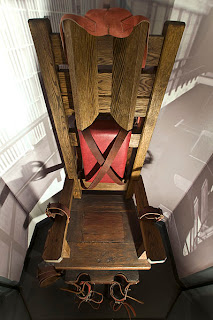Tuesday, 27 September 2011
Shocking vocabulary
Its first
recorded use in English was on 7 June 1889 when New Jersey’s Trenton Times described
how a prisoner had volunteered to be ‘electrocuted’ by “testing the new apparatus for executing by
electricity”.
New Jersey was not the first state to trial the electric chair, a dubious
honour which instead fell to New York. The State of New York set up a committee
to determine a more humane method of execution than hanging. The development of
the first electric chair became inextricably linked to the bitter contest
between Thomas Edison and George Westinghouse over electrical standards (the so
called ‘war of the
currents’). The former had championed direct current (DC) and the latter
alternating current (AC).
In the end, the first person to be executed by the electric chair was William
Kemmler in New York's Auburn Prison on August 6, 1890. The "state
electrician", taking the place of the executioner, was Edwin F. Davis. This
first attempt was not a huge success, taking several attempts before the
prisoner was finally killed. The New York Herald reported:
“Then
from the chair came a sizzling sound, as of [meat] cooking on hand. Following
it immediately a billow of smoke came from the body and filled the air of the
room with the odor of burning hair.”
Edison had succeeded in ensuring that Westinghouse’s
AC standard was used for the electric chair, and must have been delighted that
the verb ‘to Westinghouse’ came to be used for electrocution. George Westinghouse
was more succinct, noting that “they
could have done better with an axe”.
Subscribe to:
Post Comments (Atom)

No comments:
Post a Comment